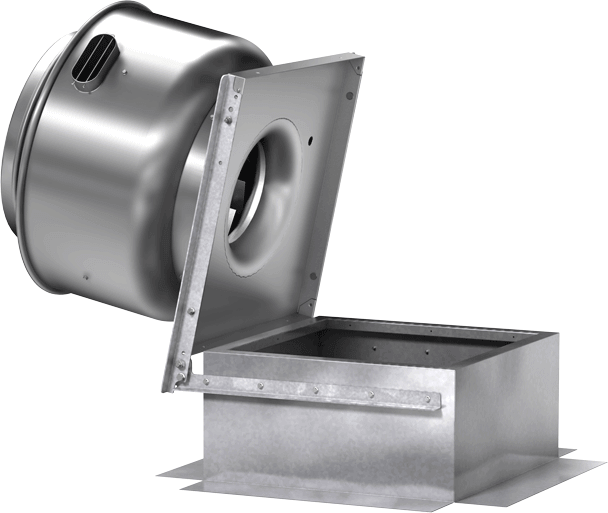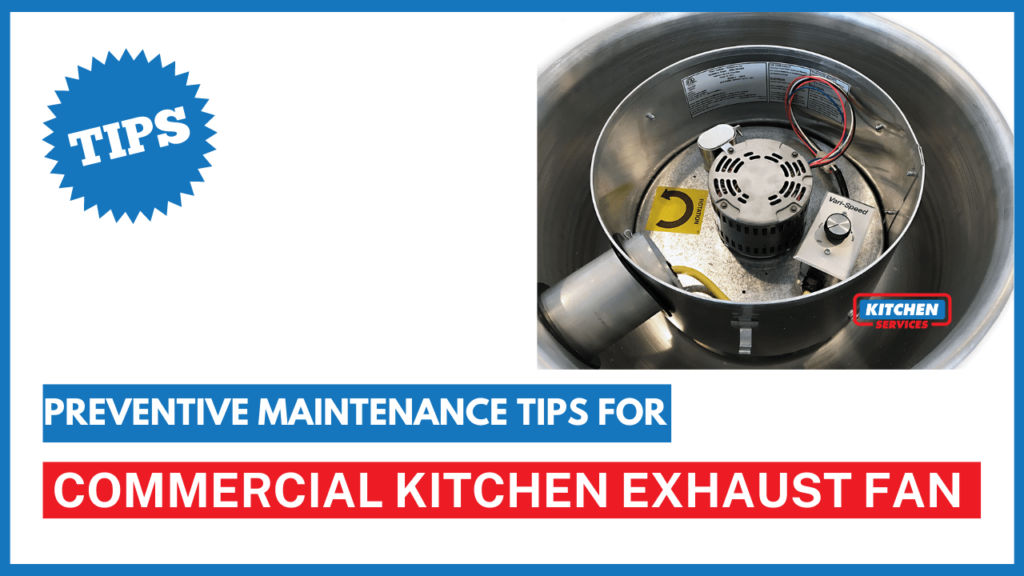If you have roof-mounted commercial kitchen exhaust fans then that must be the case with you too. they often get out-of-sight and out-of-mind, they only gain the attention that they really deserve when they are not in the functioning position. All of your installed exhaust fans have a very important job to do, so commercial kitchen exhaust fan maintenance is very important. Do not wait at all before you get them fixed at the proper time and not just before they get broken, and even for a little time, your foodservice operation has to close down.
In this article, you can learn a lot about how even a little preventive maintenance will help in making sure your ventilation system, which is the exhaust fan, has a long life and remains fully operational.
Advantages of Commercial Kitchen Exhaust Fan Maintenance

Preventive maintenance does not always take a lot of your time as you think it may. In just a little time, with not a lot of your efforts, you can keep your exhaust fan system at its best. You will feel a lot of peace and save a lot of your time and money if you do not deal with last-minute tragedies. The major advantage of preventive maintenance is that you extend the life of your exhaust and all of its elements. All these routine preventive measures can help you to get rid of many expensive component change-outs and can keep your exhaust fan from suffering an early breakdown.
With the proper care of your fan exhaust fan, it will get more energy capable. This can save your money on operating costs. As a matter of fact, routine preventive maintenance of rooftop ventilation systems has been shown to result in energy savings of as much as 11%.
Also Read: Commercial Kitchen Exhaust Grease duct Cleaning
Detailed Preventive Maintenance Tips for Commercial Kitchen Exhaust Fans

1. Examine and Modify Fan Belts
If you continue in routine to visually inspect and adjust your commercial kitchen exhaust fan belt you will observe that it has the proper tension and that it is not sliding off. You always have to be extra careful with the fitting of the belt that it should not get overly tight because if it gets tight as it may have to bear wear and ultimately, the premature failure of bearings and other important parts can occur. Usually, the fan belts do not last long so it is also very essential to observe if there are any signs of weakening in the belts so you may replace any cracked or weak belts. If you ever notice a fan belt is riding low in the pulley during your assessment, you will immediately have to change it.
2. Install a Commercial Kitchen Exhaust Fan Pivot
If you repeatedly lift a heavy roof-mounted ventilator exhaust on and off there are the chances that your fan base may cause the fan to get crooked or it even can break from where it is attached to your kitchen’s roof curb or the fan shroud. An easy but very successful solution is the installation of your exhaust fan pivot kit.
The pivot kit will allow these exhaust fans to be angled in a way that they remain safe instead of it having to be removed completely. This step will also help in providing extra stiffness to the fan base. Apart from protecting your exhaust fan in a proper way, it will also protect your rooftop.
3. Examine Your Cords and Electrical Wiring
You should always make sure that there is enough of extra slack in the electrical wiring which can allow the fan to be bent back to the open position as it was. You can examine its wiring and cords for any signs of weakening or distressing. Always make sure that there are no twists in the cords and that all electrical connections are completely safe. Any of the electrical cords and wiring should never be exposed to any hot surfaces, grease, or chemicals.
4. Check if the Fan Blades Are properly adjusted
If you ever witness that your commercial kitchen exhaust fan blades are not properly adjusted, you should keep in mind that it may cause additional vibration. When any situation like this happens, it will cause your complete rooftop unit to vibrate, which may cause nails, bolts, and other parts to get loose and lose their grip on it. This can reduce the fan’s productivity and in this way, it may compromise the safety of its attachment to the rooftop. You must regularly check your fan if it is causing any additional vibrations. In case you notice any of it, always make sure that the fan blades are totally clean on both of their sides. Always check for any buildup and remove it immediately. Even if the amount of grease is very small, if it is in the wrong place, it can upset the whole balance and cause a lot of problems. You should always regularly check the fan if there is any damage to its blade building, which is also one of the reasons that it may cause an unbalance.
5. Keep Your Motor and Fan Lubricated
If you want to keep your commercial kitchen exhaust fan in the best of its shape, you should always try to keep the fan bearings, fan shaft, and motor very well lubricated. As we know that the friction from the fan shaft spinning on the bearing housings can be the reason cause extreme heat that can even lead to fire production. This can cause so much damage to the fan intake or blades that the only option that would be left for you will be to change the entire system.
You should always oil the motors, the fan and damper bearings, the valve stems, and the fan and damper linkages for perfect lubrication. In this way, you will significantly expand the life of all of its parts as well as the fan.
6. Check the Seals on Motor Covers and Air Intakes
Never forget the value of keeping fats, oils, and grease from entering the motor housing and air intakes of your exhaust system. You can always do a rapid check to make sure that the seals on covers to prevent any sort of harm to the motor. While you are already checking it, make sure to check for any other wear and tear on your commercial kitchen exhaust fan motor.
7. Inspect for Old Vibration Isolators
Old vibration isolators are the basic problem that can cause your commercial kitchen exhaust fans. These rubber connectors actually hold the framing section of your exhaust fan and will always work as a shock absorber. As they get older, they begin to dry out and break down. When a situation like this occurs, you may notice an increase in fan vibrations and in extreme cases, a jingling noise as well.
For your information, vibration isolators are very reasonable and easy to replace. But only if you catch the problem in the early hours. If you delay or fail to replace the vibration isolators in the appropriate time, there are chances that your fan’s blades can get knocked off-center, this may cause pricey damage to blades, bearing, and a lot more.
8. Check the Exterior of Your Exhaust Fan
It is very obvious that the exhaust fans that are roof-mounted are most likely to get exposed to a lot of harsh weather, high winds, snow, rain, severe heat, or cold. You must always keep a close eye on the outer equipment. Always look if there are any leaks as well as any deterioration or weakening.
Also, you should check if any harm may have occurred from any airborne items that may have crashed into the fan. It may seem tiny, but you should always replace a rusty or broken panel, roof curb, or even tightening a loose screw that will make a large difference.
9. Do a Rapid Recheck After Any Assessment, Maintenance, or Repairs
Being human there are always the chances of mistakes, even professionals and certified people can make any sort of mistakes. After every routine inspection, maintenance, or repair is done, always check the equipment all over again. You must confirm that each screw, cable, cord, strap, and panel have been correctly tightened, reinstalled, or reconnected. You must also make sure that no debris, trash, or tools have been left on the rooftop. Anything that is not secured to the roof can become a windblown danger to your equipment.
How often should hood vents be cleaned?
You should plan routine cleanings of your hood vents fan in order to keep the airflow limitless. In the case of restaurant kitchen exhaust fan maintenance, you should consider monthly cleaning. But for residential kitchen exhaust fans, you can do it after every 6 months.
How do you clean kitchen vent fans?
In order to clean kitchen vent fans, you should.
- Take off all the screws that are holding the fan entirely
- Put the cover and the blades in warm water and a mild soap solution.
- Remove the extra grease on the fan blades by rubbing soft brush bristles on them
- After cleaning, rinse it well and dry it with a clean paper towel
- Finally, put all the pieces together.
How to clean an exhaust fan without removing it?
Yes, you can clean your exhaust fan without removing it at all. Though, it will not be as helpful as you can do by removing it. You can mix the mild detergent solution in warm water and wear your synthetic rubber gloves. Take a cotton cloth and softly scrub the exhaust fan blades one after another.
How long do kitchen extractor fans last?
On average the life of kitchen extractor fans is expected to be almost ten years. Though, you can increase their lifespan by carrying out regular maintenance check-ups of your kitchen exhaust fans.
What is a hinge kit in the kitchen exhaust fan?
Hinge kits come in a pair; a hinge kit is present on the kitchen exhaust fan. It can allow the cleaning crew to open the duct shaft from the top and turn the fan to the side. Your hood cleaning is unfinished without an appropriate hinge kit in the kitchen exhaust fan.
Conclusion
You can always create a written program for the preventive maintenance of your commercial kitchen hood and exhaust system. Every time you do a detailed examination, you should always write down the results and note any disciplinary action that is taken. Keep in mind that a simple checklist can go a long way to keep your restaurant kitchen safe from fires that are caused by improperly maintained or cleaned kitchen hoods.

